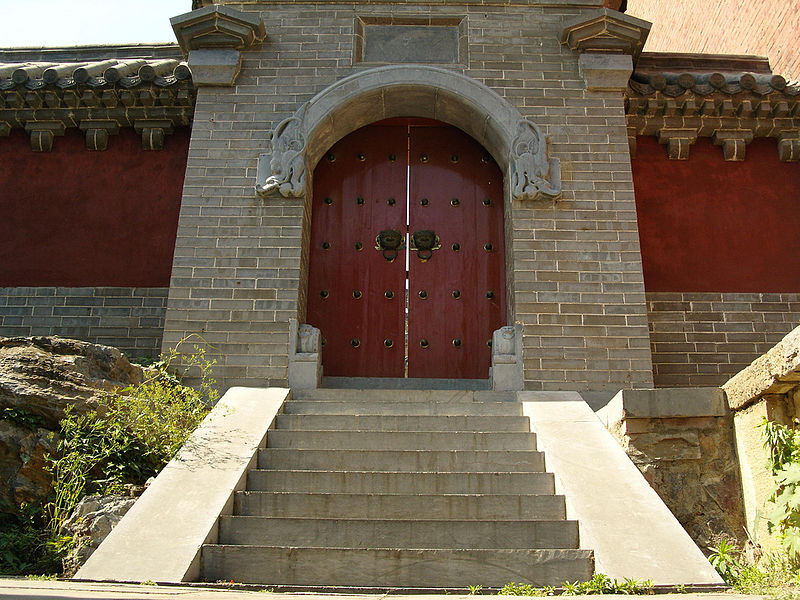





 |
 |
 |
 |
 |
 |
|---|---|---|---|---|---|
 |
 |
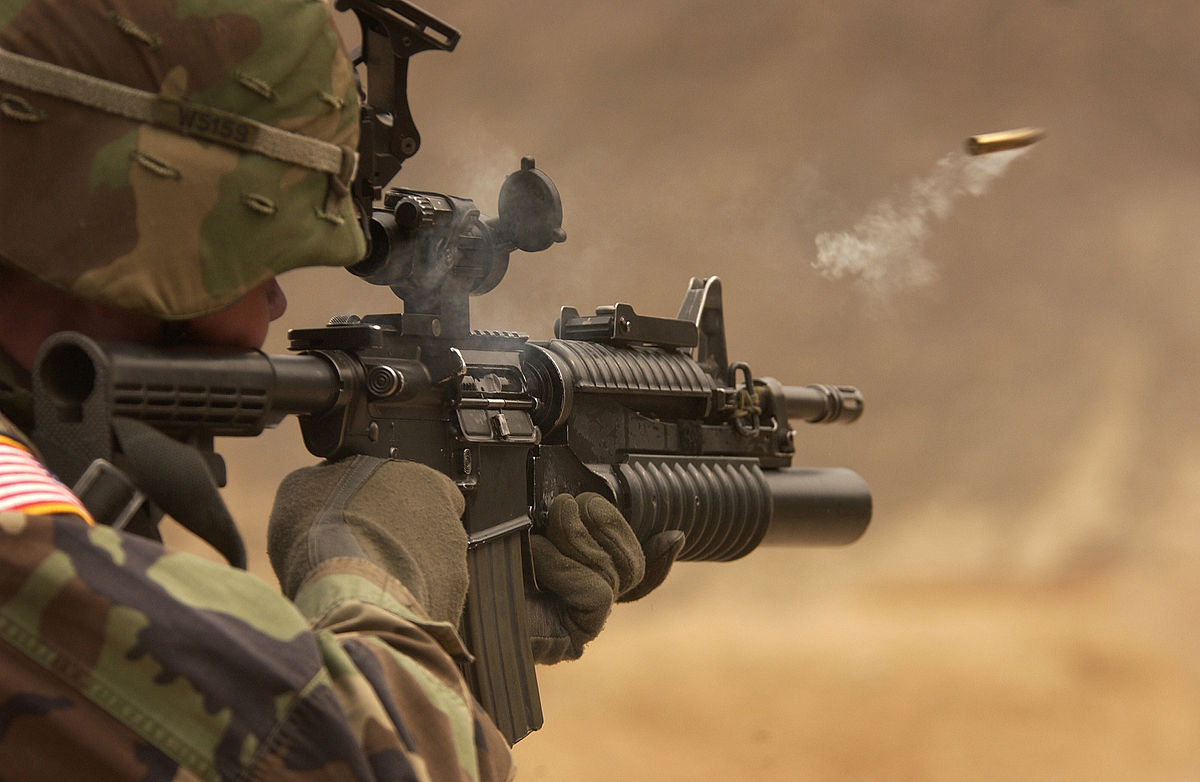 |
|---|---|---|
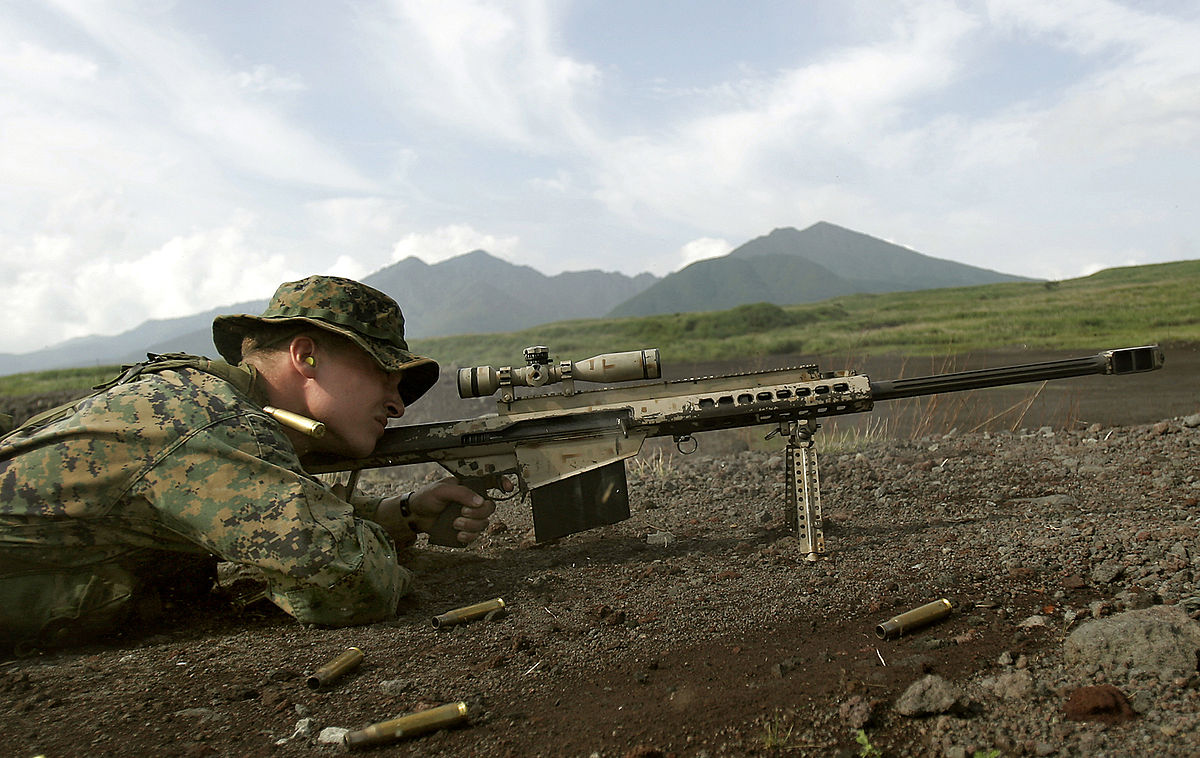 |
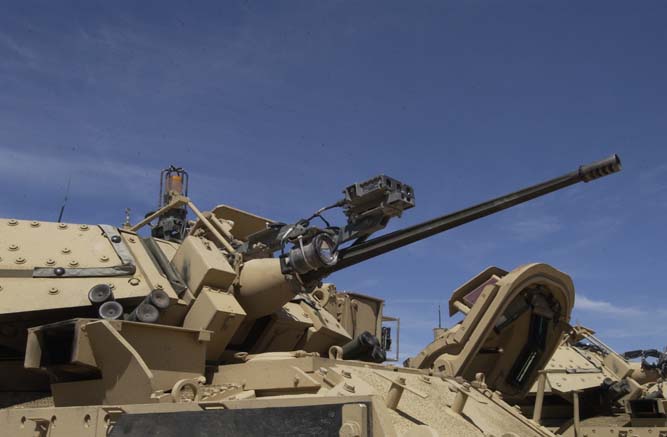 |
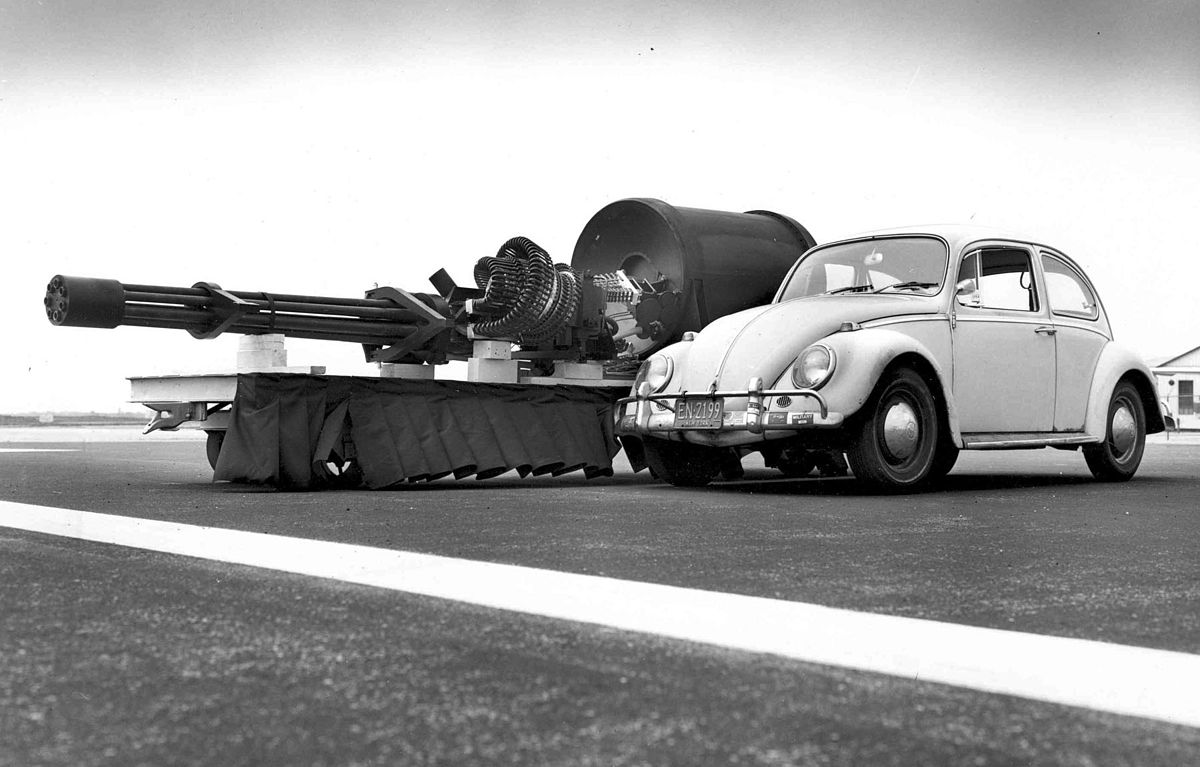 |
|---|---|---|
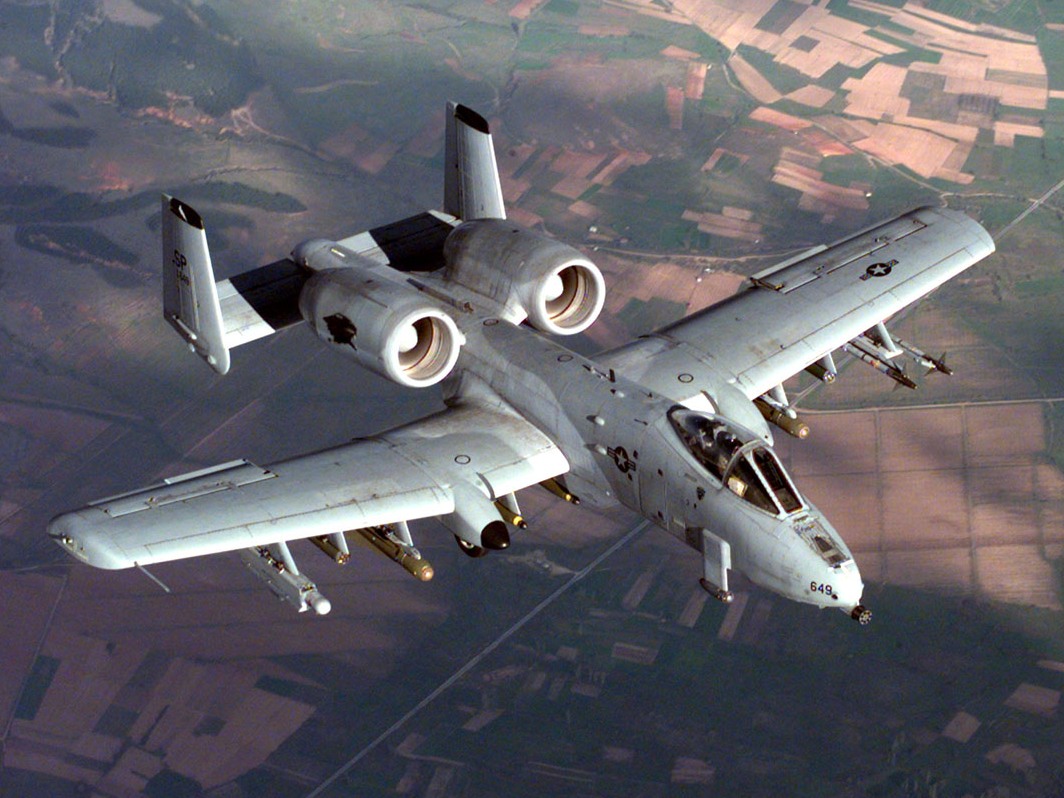 |
 |
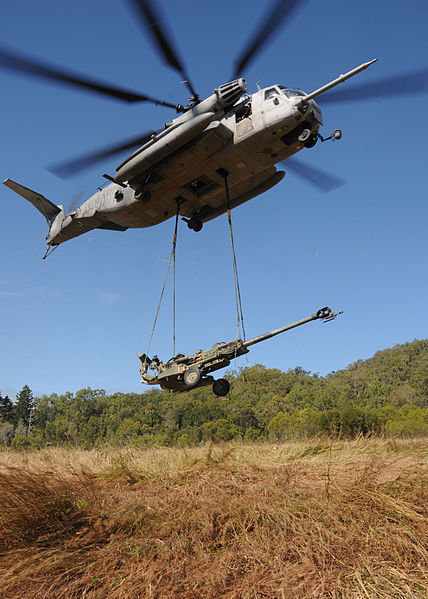 |
|---|---|---|
 |
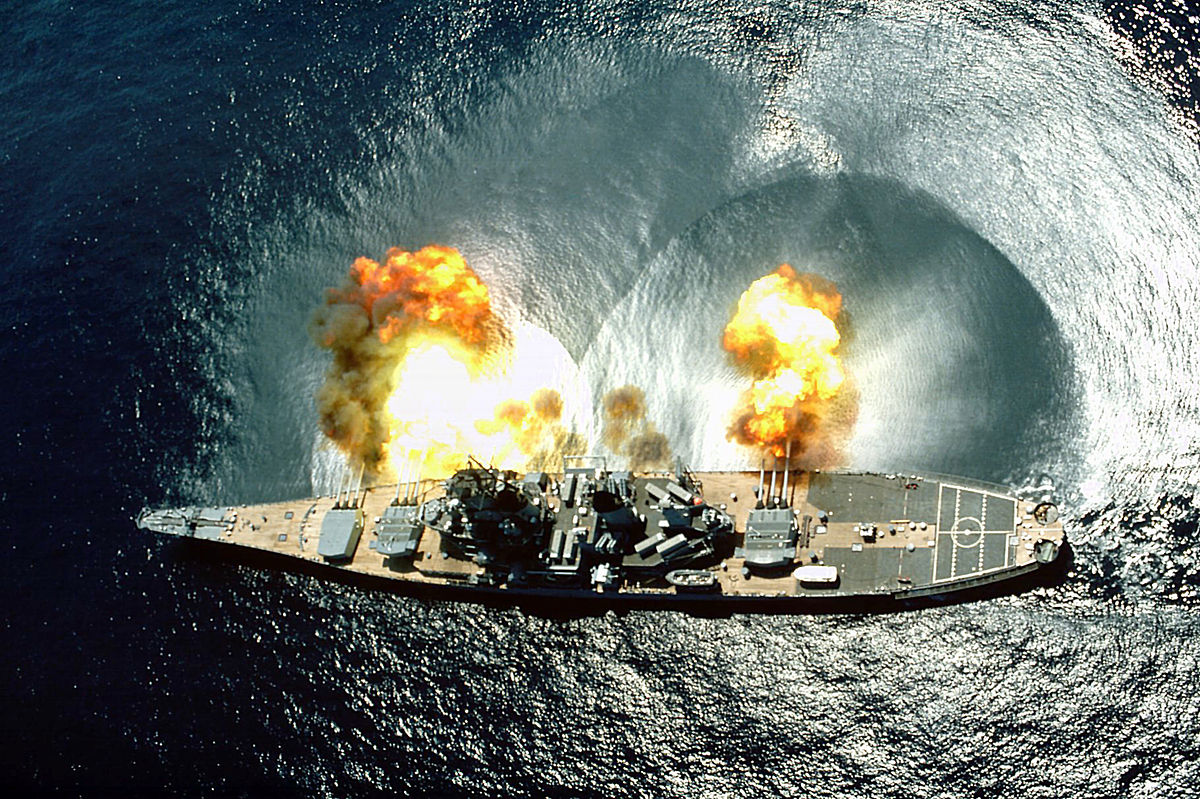 |
|---|---|
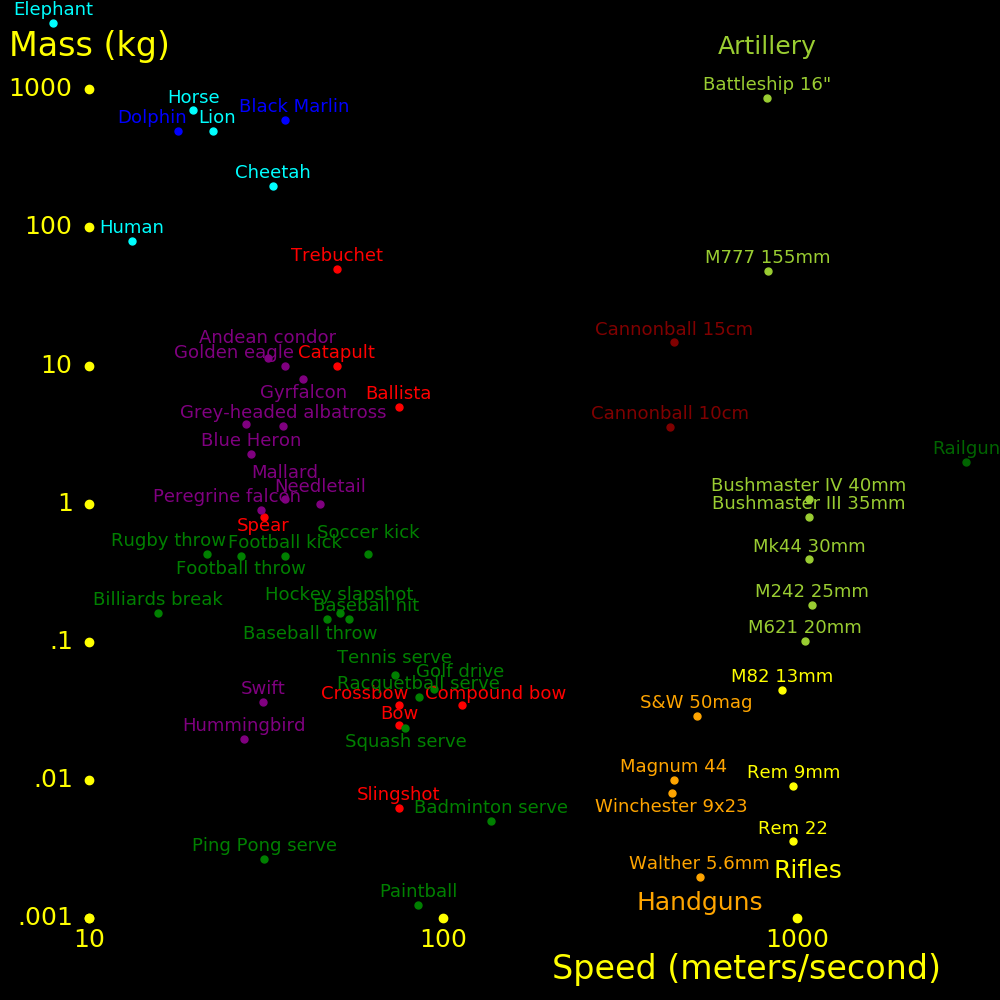 |
|---|
Bullet Bullet Speed Energy Barrel Gun Fire Vehicle Cartridge
diam mass rate mass
mm kg m/s kJoule meters kg Hertz tons
Swiss Mini Gun 2.3 .00013 122 .00097 .0018 .020
Chiappa 17 4.4 .0010 560 .16 .121 .17 PMC/Aguila
Chiappa 17 4.4 .0010 640 .20 .121 .17 HM2
SPP-1 4.5 .0128 245 .38 .95 4.5x40mmR
Heckler Koch MP7 4.6 .0020 735 .54 .180 1.9 HK 4.6x30mm
Walther PPK 5.6 .0020 530 .281 .083 .560
Walther PPK 5.6 .0030 370 .141 .083 .560
Walther PPK/S 7.65 .0050 318 .240 .083 .630
Walther PPK/E 9.0 .0065 323 .338 .083 .665
Luger 9mm 9.0 .0081 354 .102
Winchester 9x23 9.0 .0081 442
Colt 45 11.4 .0100 262 .127
Magnum 44 11.2 .0156 448 .165
Smith Wesson 460 11.5 .019 630 3.77 .213 .460 SW Magnum
Magnum DesertEagle 12.7 .019 470 .254 1.996 .50 Action Express
Smith Wesson 50mag 12.7 .026 550 .267 2.26
Smith Wesson 50mag 12.7 .029 520 3.92 .267 2.26
Smith Wesson 50mag 12.7 .032 434 3.01 .267 2.26 .500 SW Magnum
MagnumResearch BFR 12.7 .026 550 3.93 .254 2.40 .50 Beowulf
Ruger 96 4.4 .0013 720 .34 .47 2.38 .17 HMR
Ruger M77 5.2 .0026 1200 1.83 .61 3.74 .204 Ruger
CMMG MK47 Mutant 5.6 .0036 975 Remmington 22
Remmington 9mm 9.0 .0091 975
M4 Carbine 5.56 .0041 936 1.80 .370 2.88 15.8
FN SCAR-H Rifle 7.62 .011 790 3.51 .400 3.58 10.4 20 round magazine
Barrett M82 13.0 .045 908 18.9 .74 14.0 10 round magazine
Hannibal 14.9 .049 750 13.8
CZ-550 15.2 .065 914 27.2 .600 Overkill
Vidhwansak 20 .13 720 33.7 1.0 26 20x81 mm. 3 round magazine
RT-20 20 .13 850 47 .92 19.2 1 round magazine
M621 cannon 20 .102 1005 51.5 45.5 13.3 20x102 mm
M61 Vulcan 20 .102 1050 56.2 92 110 20x102. 6 barrels
Oerlikon KBA 25 .184 1335 164 2.888 112 10
M242 Bushmaster 25 .184 1100 111 2.175 119 8.3 27.6 M2 Bradley
GAU-12 Equalizer 25 .184 1040 99.5 122 70 6.3 Harrier 2. 5 barrels
M230 chain gun 30 .395 805 128 55.9 10.4 5.2 Apache. 30x113 mm
Mk44 Bushmaster 2 30 .395 1080 230 2.41 160 3.3 27.6 M2 Bradley. 30x173 mm
GAU-8 Avenger 30 .395 1070 226 2.30 281 70 11.3 A-10 Warthog. 30x173 mm. 7 barrels
Bushmaster III 35 1180 218 3.3 35x228 mm
Bushmaster IV 40 1.08 198 3.3 40x365 mm
Rheinmetall 120 120 8.350 1750 12800 6.6 4500 .1 62 M1 Abrams tank
M777 Howitzer 155 48 827 16400 5.08 4200 .083
Iowa Battleship 406 862 820 290000 20.3 121500 .033 45000
2 bore rifle 33.7 .225 460 23.7 .711 4.5 Historical big-game rifle
Cannonball 6 lb 87 2.72 438 261 2.4
Cannonball 9 lb 96 4.08 440 395 2.7
Cannonball 12 lb 110 5.44 453 558 2.4
Cannonball 18 lb 125 8.16 524 1120 2.6 2060
Cannonball 24 lb 138 10.89 524 1495 3.0 2500
Cannonball 32 lb 152 14.5 518 1945 3.4 2540
Cannonball 36 lb 158 16.33 450 1653 2.9 3250
Cannonball diameters are calculated from the mass assuming a density of 7.9
g/cm3.
 |
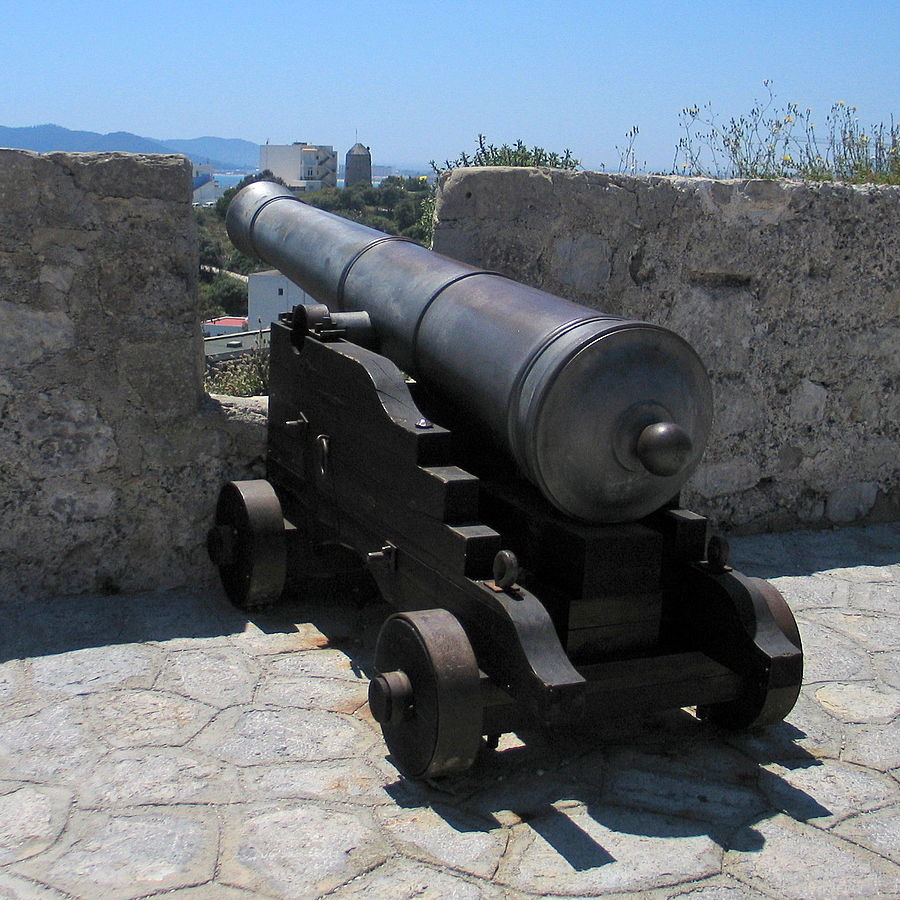 |
|---|---|
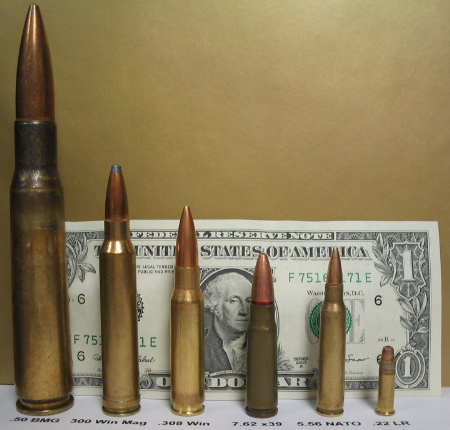 |
|---|
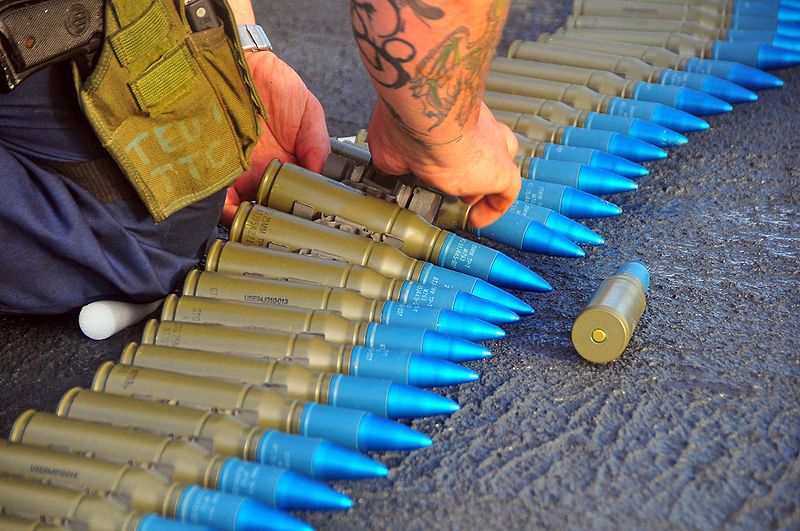 |
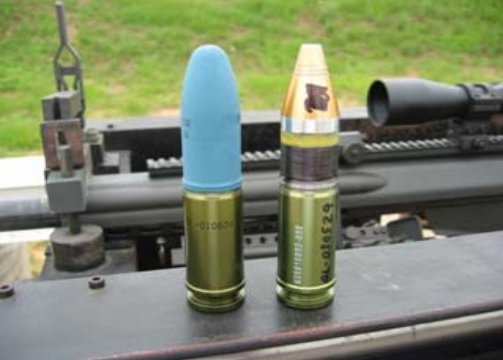 |
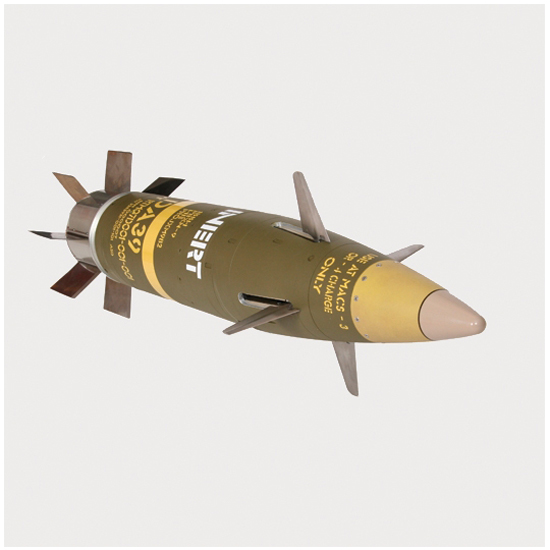 |
|---|---|---|
The energy distribution for a 7.62 mm Hawk bullet is
Bullet energy .32 Hot gas .34 Barrel heat .30 Barrel friction .02 Unburnt powder .01To estimate the velocity of a bullet,
Energy efficiency = e = .32 (Efficiency for converting powder energy to bullet enery) Bullet mass = M Powder mass = m Powder energy/mass = Q = 5.2 MJoules/kg Bullet velocity = V Bullet energy = E = ½ M V2 = e Q m (Kinetic energy = Efficiency * Powder energy) V = (2 e Q m / M)2 = 1820 (m/M)½ meters/second
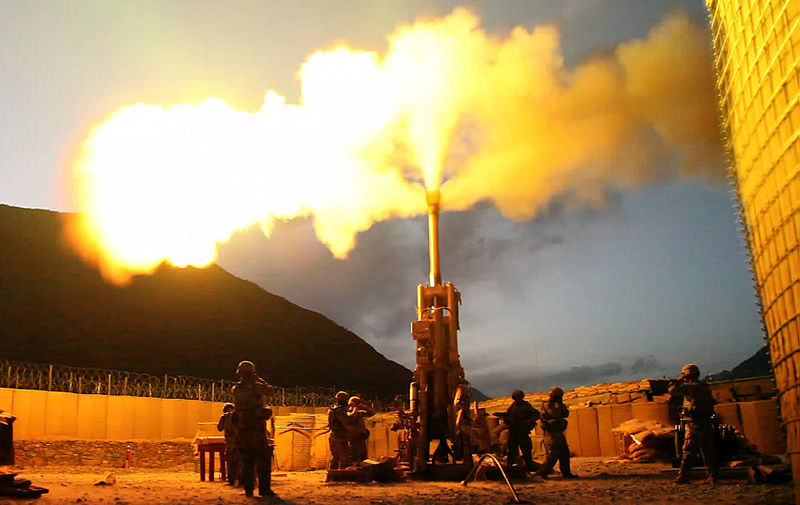 |
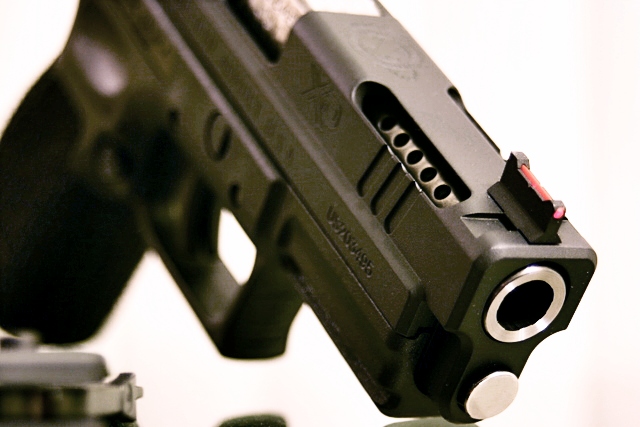 |
|---|---|
The muzzle break at the end of the barrel deflects gas sideways to reduce recoil.
 |
 |
 |
|
|---|---|---|---|
MJoules Rocket Shock Density Boil
/kg km/s km/s g/cm3 Kelvin
Beryllium+ O2 23.2 5.3
Aluminum + O2 15.5
Magnesium+ O2 14.8
Hydrogen + O2 13.2 4.56 .07 20
Kerosene + O3 12.9
Octanitrocubane 11.2 10.6 1.95
Methane + O2 11.1 3.80 .42 112 CH4
Octane + O2 10.4 .70 399 C8H18
Kerosene + O2 10.3 3.52 .80 410 C12H26
Dinitrodiazeno. 9.2 10.0 1.98
C6H6N12O12 9.1 1.96 China Lake compound
Kerosene + H2O2 8.1 3.2
Kerosene + N2O4 8.0 2.62
HMX (Octogen) 8.0 3.05 9.1 1.86
RDX (Hexagen) 7.5 2.5 8.7 1.78
Al + NH4NO3 6.9
Nitroglycerine 7.2 8.1 1.59 Unstable
PLX 6.5 1.14 95% CH3NO2 + 5% C2H4(NH2)2
Composition 4 6.3 8.04 1.59 91% RDX. "Plastic explosive"
Kerosene + N2O 6.18
Dynamite 5.9 7.2 1.48 75% Nitroglycerine + stabilizer
PETN 5.8 8.35 1.77
Smokeless powder 5.2 6.4 1.4 Used after 1884. Nitrocellulose
TNT 4.7 6.9 1.65 Trinitrotoluene
Al + Fe2O3 4.0 Thermite
H2O2 2.7 1.59 1.45 423 Hydrogen peroxide
Black powder 2.6 .6 1.65 Used before 1884
Al + NH4ClO4 2.6
NH4ClO4 2.5
N2O 1.86 1.76
N2H4 1.6 2.2 1.02 387 Hydrazine
Bombardier beetle .4 Hydroquinone + H2O2 + protein catalyst
N2O4 .10 1.45 294
Rocket: Rocket exhaust speed
Shock: Shock speed
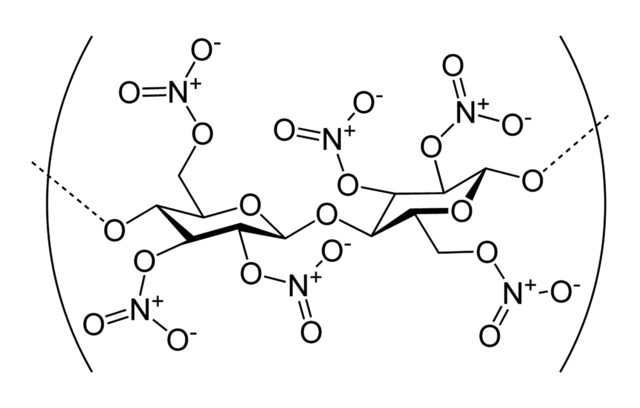 |
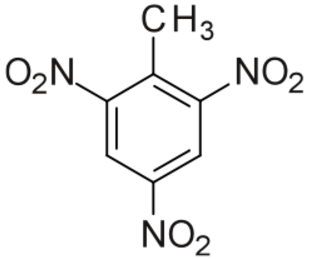 |
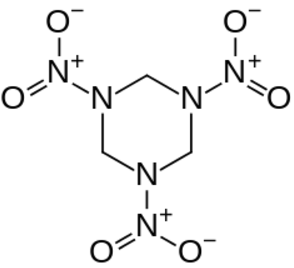 |
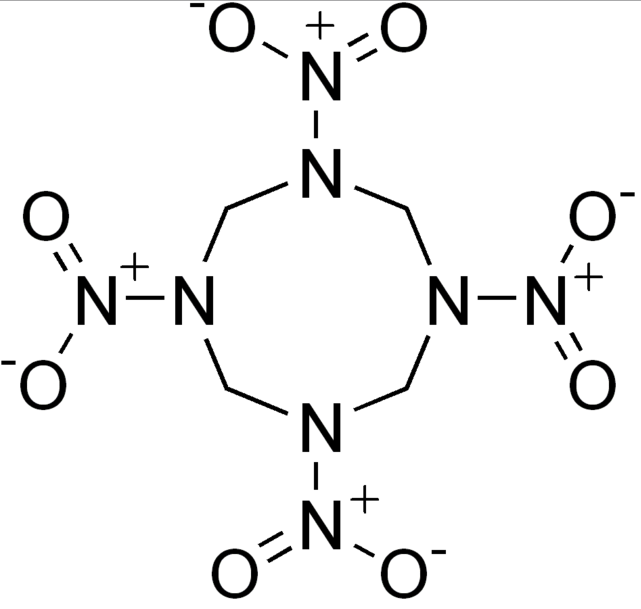 |
 |
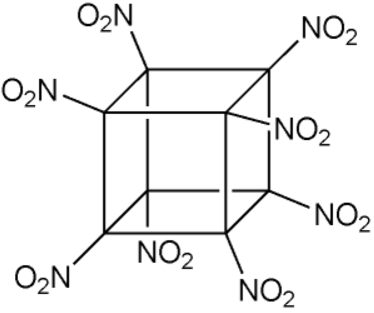 |
|---|---|---|---|---|---|
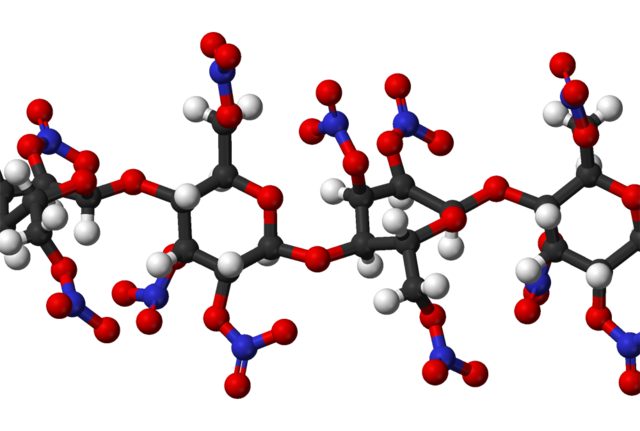 |
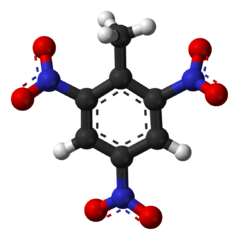 |
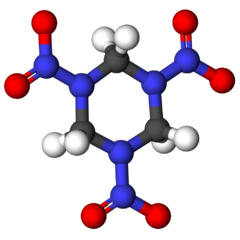 |
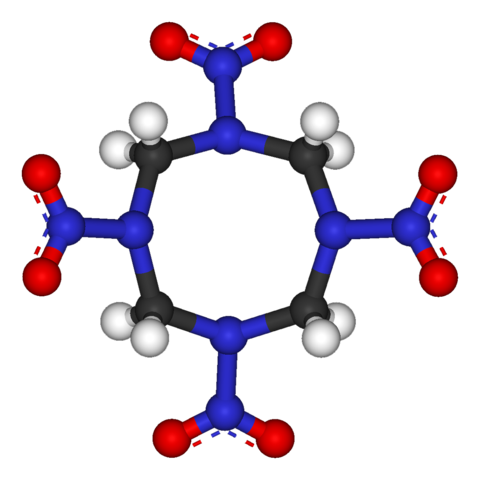 |
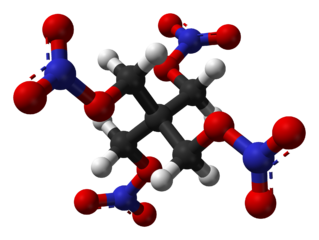 |
 |
|---|---|---|---|---|---|
 |
 |
|---|---|
High explosives have a large shock velocity.
MJoules Shock Density
/kg km/s g/cm3
Octanitrocubane 11.2 10.6 1.95
Dinitrodiazeno. 9.2 10.0 1.98
C6H6N12O12 9.1 1.96 China Lake compound
HMX (Octogen) 8.0 9.1 1.86
RDX (Hexagen) 7.5 8.7 1.78
PLX 6.5 1.14 95% CH3NO2 + 5% C2H4(NH2)2
Composition 4 6.3 8.04 1.59 91% RDX. "Plastic explosive"
Dynamite 5.9 7.2 1.48 75% Nitroglycerine + stabilizer
PETN 5.8 8.35 1.77
~808 Qing Xuzi publishes a formula resembling gunpower, consisting of
6 parts sulfur, 6 parts saltpeter, and 1 part birthwort herb (for carbon).
~850 Incendiary property of gunpower discovered
1132 "Fire lances" used in the siege of De'an, China
1220 al-Rammah of Syria publishes "Military Horsemanship and Ingenious War
Devices", describes the purification of potassium nitrate by
adding potassium carbonate with boiling water, to precipitate out
magnesium carbonate and calcium carbonate.
1241 Mongols use firearms at the Battle of Mohi, Hungary
1338 Battle of Arnemuiden. First naval battle involving cannons.
1346 Cannons used in the Siege of Calais and the Battle of Crecy
1540 Biringuccio publishes "De la pirotechnia", giving recipes for gunpowder
1610 First flintlock rifle
1661 Boyle publishes "The Sceptical Chymist", a treatise on the
distinction between chemistry and alchemy. It contains some of the
earliest modern ideas of atoms, molecules, and chemical reaction,
and marks the beginning of the history of modern chemistry.
1669 Phosphorus discovered
1774 Lavoisier appointed to develop the French gunpowder program. By 1788
French gunpowder was the best in the world.
1832 Braconnot synthesizes the first nitrocellulose (guncotton)
1846 Nitrocellulose published
1847 Sobrero discovers nitroglycerine
1862 LeConte publishes simple recipes for producing potassium nitrate.
1865 Abel develops a safe synthesis of nitrocellulose
1867 Nobel develops dynamite, the first explosive more powerful than black powder
It uses diatomaceous earth to stabilize nitroglycerine
1884 Vieille invents smokeless gunpowder (nitrocellulose), which is 3 times
more powerful than black powder and less of a nuisance on the battlefield.
1902 TNT first used in the military. TNT is much safer than dynamite
1930 RDX appears in military applications
1942 Napalm developed
1949 Discovery that HMX can be synthesized from RDX
1956 C-4 explosive developed (based on RDX)
1999 Eaton and Zhang synthesize octanitrocubane and heptanitrocubane
Black powder = .75 KNO3 + .19 Carbon + .06 Sulfur
Above 550 Celsius, potassium nitrate decomposes. 2 KNO3 ↔ 2 KNO2 + O2.
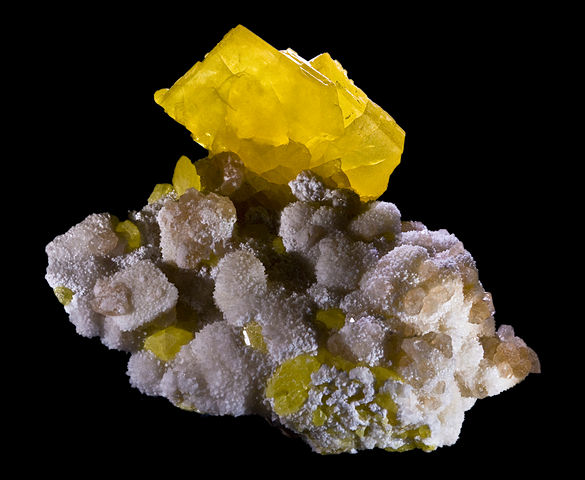 |
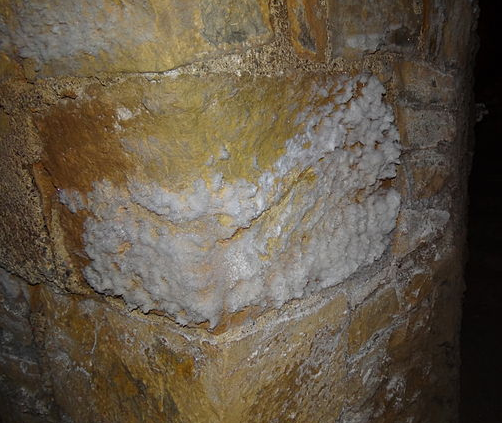 |
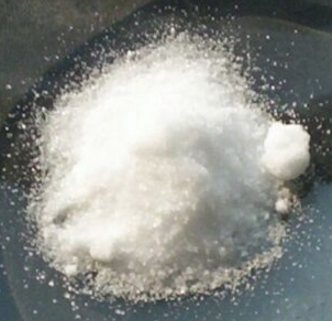 |
|
|---|---|---|---|
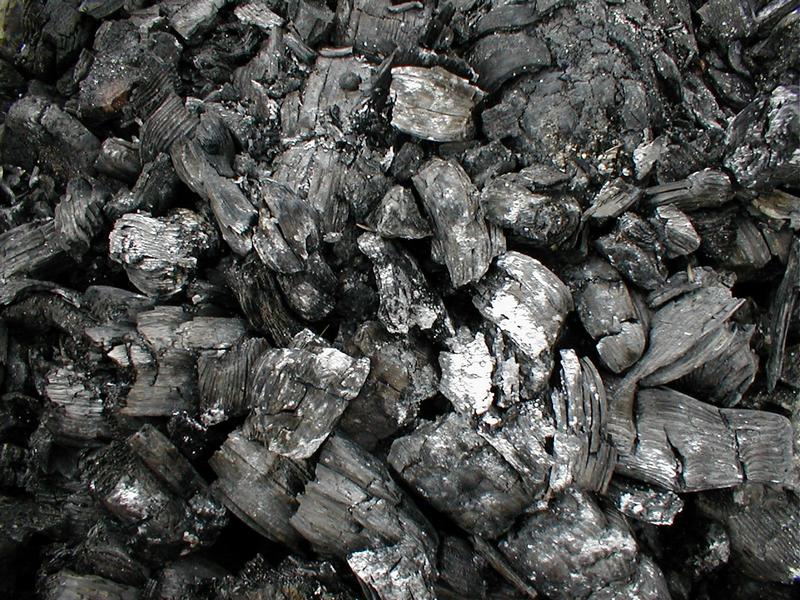 |
 |
 |
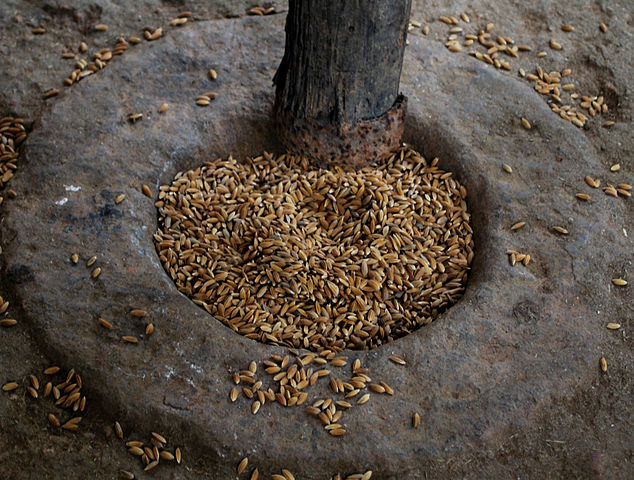 |
|---|---|---|---|
Potassium nitrate KNO3 75% (Saltpeter) Charcoal C7H4O 15% Sulfur S 10% Oversimplified equation: 2 KNO3 + 3 C + S → K2S + N2 + 3 CO2 Realistic equation: 6 KNO3 + C7H4O + 2 S → KCO3 + K2SO4 + K2S + 4 CO2 + 2 CO + 2 H2O + 3 N2Nitrite (NO3) is the oxidizer and sulfur lowers the ignition temperature.
MJoules
/kg
Hydrogen + Oxygen 13.16
Gasoline + Oxygen 10.4
Mass Energy Energy/Mass
kg MJ MJ/kg
MOAB 9800 46000 4.7 8500 kg of fuel
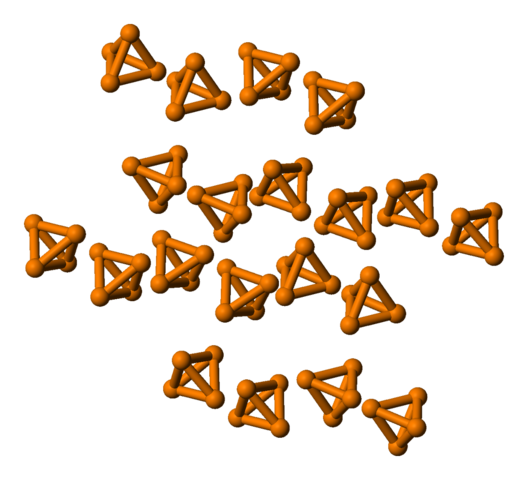 |
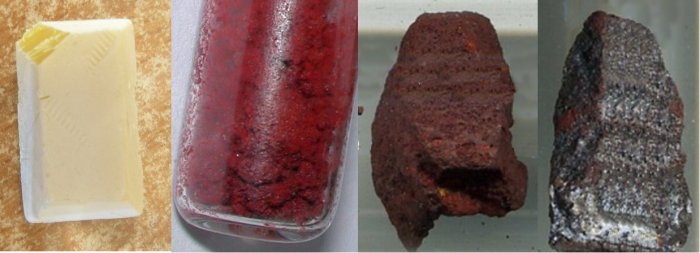 |
 |
|---|---|---|
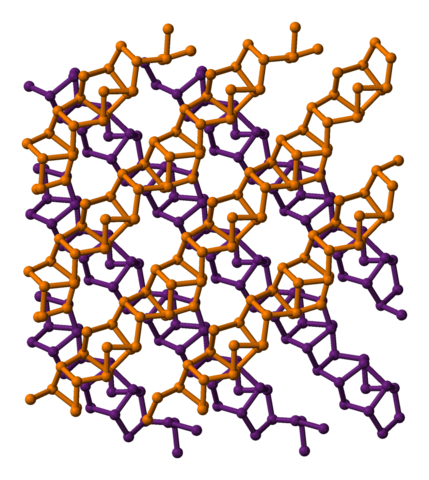 |
 |
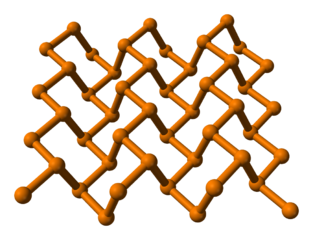 |
|---|---|---|
Form Ignition Density
(Celsius)
White 30 1.83
Red 240 1.88
Violet 300 2.36
Black 2.69
Red phosphorus is formed by heating white phosphorus to 250 Celsius or by
exposing it to sunlight. Violet phosphorus is formed by heating red phosphorus
to 550 Celsius. Black phosphorus is formed by heating white phosphorus at a
pressure of 12000 atmospheres. Black phosphorus is least reactive form and it
is stable below 550 Celsius.
 |
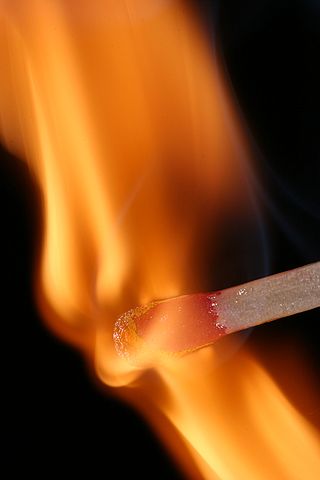 |
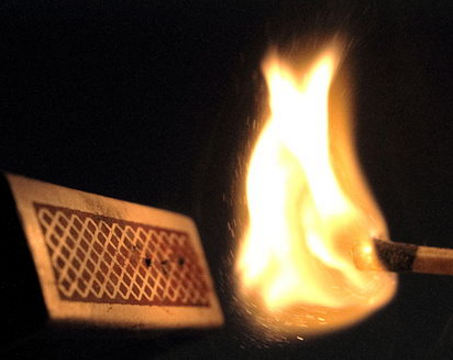 |
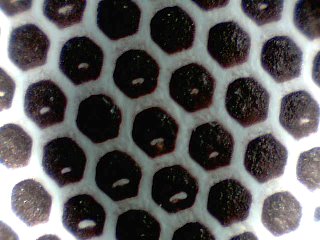 |
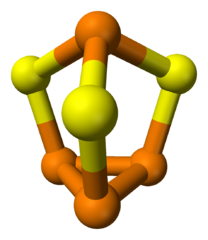 |
|
|---|---|---|---|---|---|
The safety match was invented in 1844 by Pasch. The match head cannot ignite by itself. Ignitition is achieved by striking it on a rough surface that contains red phosphorus. When the match is struck, potassium chlorate in the match head mixes with red phosphorus in the abrasive to produce a mixture that is easily ignited by friction. Antimony trisulfide is added to increase the burn rate.
Match head Fraction Striking surface Fraction Potassium chlorate KClO3 .50 Red phosphorus .5 Silicon filler Si .4 Abrasive .25 Sulfur S small Binder .16 Antimony3 trisulfide Sb2S3 small Neutralizer .05 Neutralizer small Carbon .04 Glue smallA "strike anywhere" match has phosphorus in the match head in the form of phosphorus sesquisulfide (P4S3) and doesn't need red phosphorus in the striking surface. P4S3 has an ignition temperature of 100 Celsius.
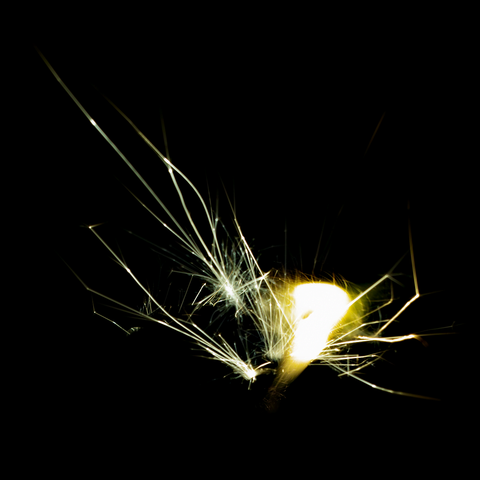 |
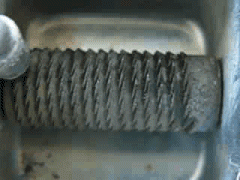 |
.jpg) |
|---|---|---|
Before the invention of iron, fires were started by striking flint (quartz) with pyrite to generate sparks. Flintlock rifles work by striking flint with iron. With the discovery of cerium, ferrocerium replaced iron and modern butane lighters use ferrocerium, which is still referred to as "flint".
Cerium .38 Ignition temperature of 165 Celsius Lanthanum .22 Iron .19 Neodymium2 .04 Praseodymium .04 Magnesium .04
 |
|---|
Nitrous oxide is stored as a cryogenic liquid and injected along with gaoline into the combustion chamber. Upon heating to 300 Celsius the nitrous oxide decomposes into nitrogen and oxygen gas and releases energy. The oxygen fraction in this gas is higher than that in air (1/3 vs. .21) and the higher faction allows for more fuel to be consumed per cylinder firing.
Air density = .00122 g/cm3 Nitrous oxide gas density = .00198 g/cm3 Diesel density = .832 g/cm3 Gasoline density = .745 g/cm3 Diesel energy/mass = 43.1 MJoules/kg Gasoline energy/mass = 43.2 MJoules/kg Nitrous oxide boiling point = -88.5 Celsius Air oxygen fraction = .21 Nitrous oxide oxygen fraction= .33 Nitrous oxide decompose temp = 300 Celsius Nitrous oxide liquid pressure= 52.4 Bars Pressure required to liquefy N2O at room temperature
 |
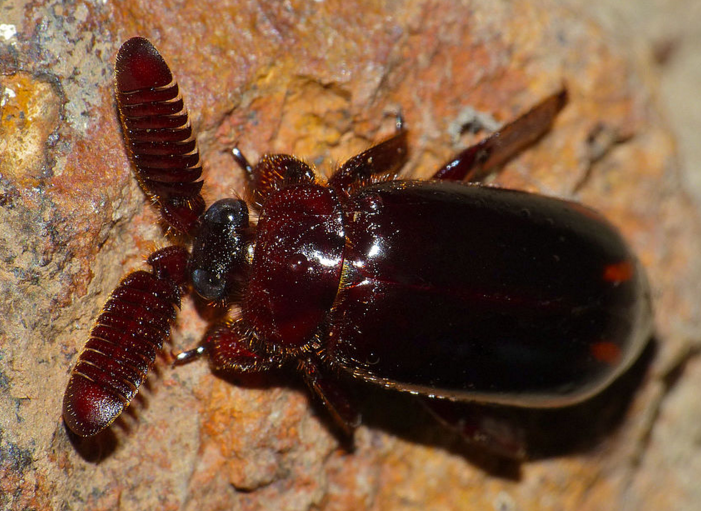 |
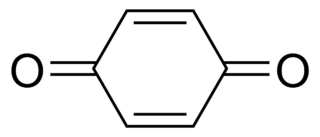 |
|---|---|---|
Hydroquinone and peroxide are stored in 2 separate compartments are pumped into the reaction chamber where they explode with the help of protein catalysts. The explosion vaporizes 1/5 of the liquid and expels the rest as a boiling drop of water, and the p-quinone in the liquid damages the foe's eyes. The energy of expulsion pumps new material into the reaction chamber and the process repeats at a rate of 500 pulses per second and a total of 70 pulses. The beetle has enough ammunition for 20 barrages.
2 H2O2 → 2 H2O + O2 (with protein catalyst) C6H4(OH)2 → C6H4O2 + H2 (with protein catalyst) O2 + 2 H2 → 2 H2O Firing rate = 500 pulses/second Number of pulses in one barrage = 70 Firing time = .14 seconds Number of barrages = 20
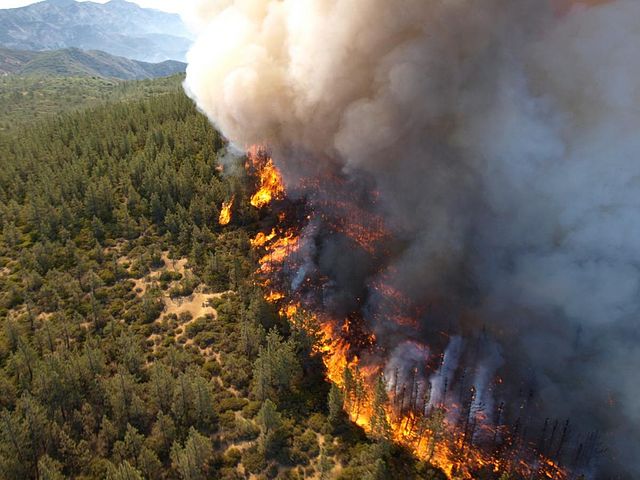 |
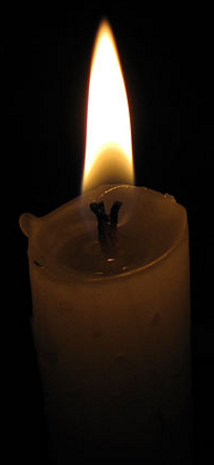 |
 |
 |
|
|---|---|---|---|---|
A turbojet engine compresses air before burning it to increase the flame speed and make it burn explosively. A ramjet engine moving supersonically doesn't need a turbine to achieve compression.
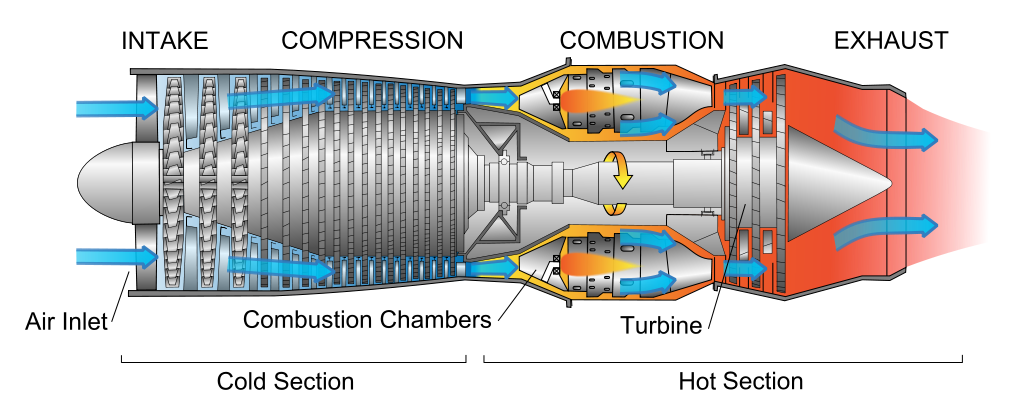 |
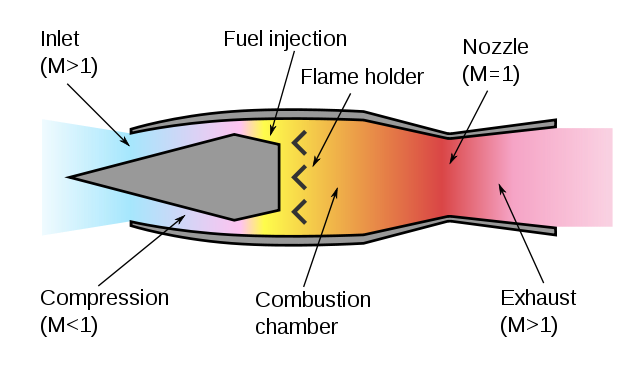 |
|---|---|
Airbus A350 compression ratio = 52 Air density at sea level = 1 bar Air density at 15 km altitude = .25 bar Air density in A350 engine = 13 barFrom the thermal flame theory of Mallard and Le Chatelier,
Temperature of burnt material = Tb Temperature of unburnt material = Tu Temperature of ignition = Ti Fuel density = Dfuel Oxygen density = Doxygen Reaction coefficient = C Reaction rate = R = C Dfuel Doxygen Thermal diffusivity = Q = 1.9⋅10-5 m2/s Flame speed = V V2 = Q C Dfuel Doxygen (Tb - Ti) / (Ti - Tu)
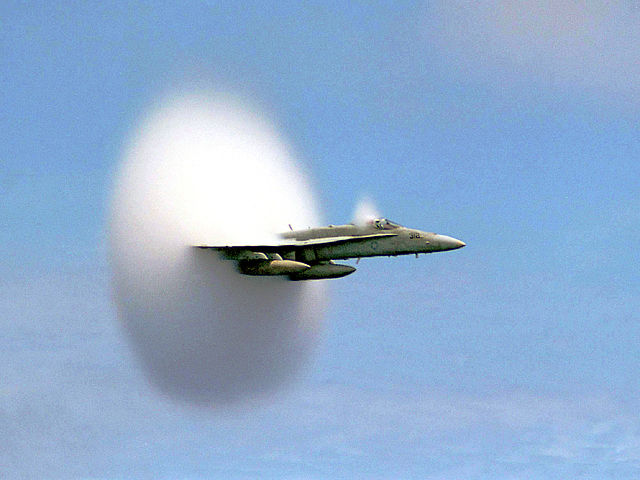 |
 |
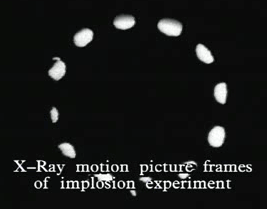 |
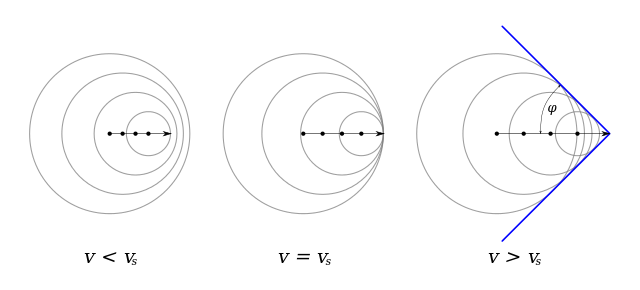 |
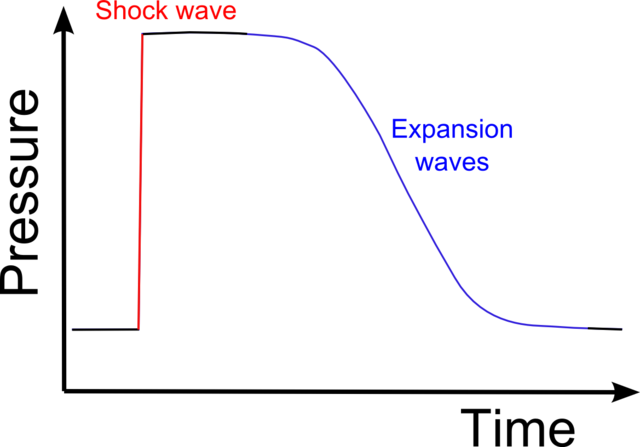 |
|---|---|---|---|---|
If the pressure front moves supersonically then the front forms a discontinuous shock, where the pressure makes a sudden jump as the shock passes.
Metal powder is often included with explosives.
Energy/mass Energy/mass
not including including
oxygen oxygen
(MJoule/kg) (MJoule/kg)
Hydrogen 113.4 12.7
Gasoline 46.0 10.2
Beryllium 64.3 23.2
Aluminum 29.3 15.5
Magnesium 24.5 14.8
Carbon 12.0 3.3
Lithium 6.9 3.2
Iron 6.6 4.6
Copper 2.0 1.6
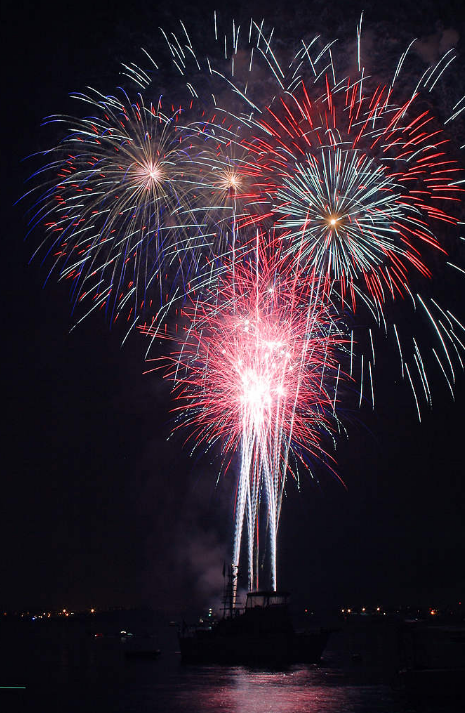 |
 |
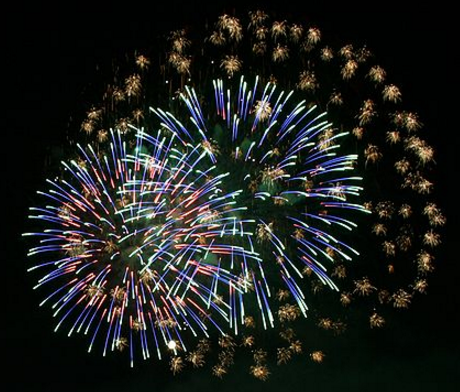 |
 |
 |
|---|---|---|---|---|
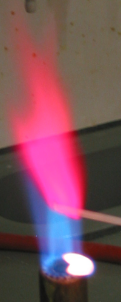 |
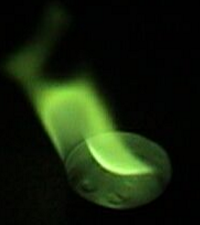 |
 |
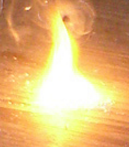 |
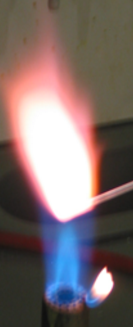 |
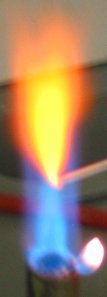 |
 |
|---|---|---|---|---|---|---|
 |
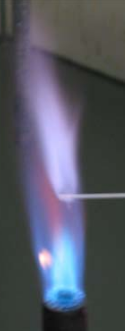 |
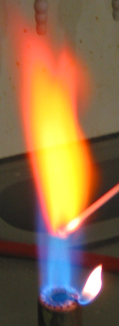 |
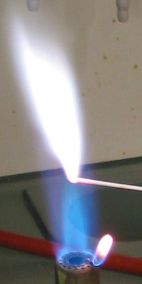 |
 |
 |
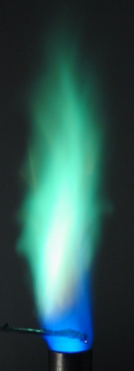 |
|---|---|---|---|---|---|---|
 |
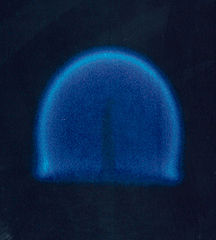 |
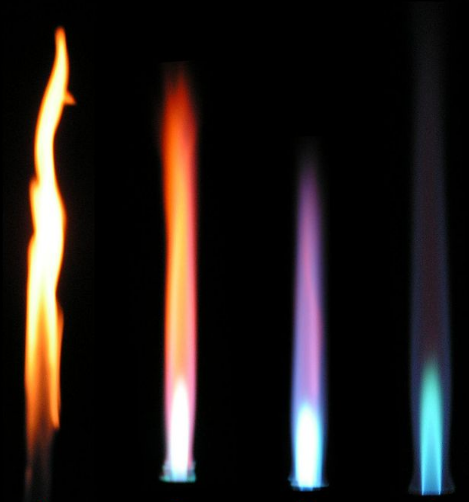 |
 |
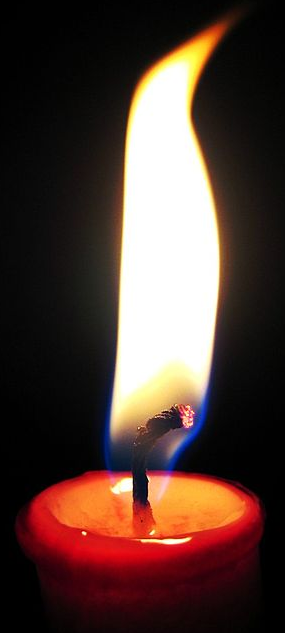 |
|---|---|---|---|---|
 |
|---|
An oxygen candle is a mixture of sodium chlorate and iron powder, which when ignited smolders at 600 Celsius and produces oxygen at a rate of 6.5 man-hours of oxygen per kilogram of mixture. Thermal decomposition releases the oxygen and the burning iron provides the heat. The products of the reaction are NaCl and iron oxide.
The best oxidizer is liquid oxygen, and the exhaust speed for various fuels when burned with oxygen is:
Exhaust Energy Density of fuel + oxidizer
speed /mass
km/s MJ/kg g/cm3
Hydrogen H2 4.46 13.2 .32
Methane CH4 3.80 11.1 .83
Ethane C2H6 3.58 10.5 .9
Kerosene C12H26 3.52 10.3 1.03
Hydrazine N2H4 3.46 1.07
Liquid hydrogen is usually not used for the ground stage of rockets because of
its low density.
We use kerosene as a standard fuel and show the rocket speed for various oxidizers. Some of the oxidizers can be used by themselves as monopropellants.
Energy/Mass Energy/Mass Rocket Rocket Boil Density
with kerosene as monopropellant with kerosene as monopropellant Kelvin g/cm3
MJoule/kg MJoule/kg km/s km/s
O3 12.9 2.97 161
O2 10.3 0 3.52 0 110 1.14
H2O2 8.1 2.7 3.2 1.6 423 1.45
N2O4 8.00 .10 2.62 294 1.44
N2O 6.18 1.86 1.76 185
N2H4 - 1.58 2.2 387 1.02
MJoules Rocket Density
/kg km/s g/cm3
C6H6N12O12 9.1 1.96 China Lake compound
HMX (Octogen) 8.0 3.05 1.86
RDX (Hexagen) 7.5 2.5 1.78
Al + NH4ClO4 2.6
NH4ClO4 2.5
NH3OHNO3 2.5 1.84 Hydrxyammonium nitrate
Al + NH4NO3 6.9
NH4NO3 1.4 2.0 1.12 Ammonium nitrate
 |
|---|
Speed Mass Energy
m/s kg Joules
Bow 74 .021 57
Compound bow 113 .035 223
Crossbow 75 .040 112
Slingshot 75 .0063 18
Ballista 75 5 14000
Trebuchet 40 100 80000
Cannonball 6 lb 438 2.7 261000
Cannonball 36 lb 450 16.3 1653000
Typical parameters for a bow and arrow are:
Arrow speed = 74 meters/second Arrow mass = 20.6 g Arrow kinetic energy = 57 Joules Bow energy = 74 Joules Energy efficiency = .77 Maximum bow force =200 Newtons Bow mass = 6.5 kg Bow mass / Arrow mass =316 Arrow length = .70 meters Arrow radius = 3.63 mm Arrow wall thickness = .50 mm Arrow tip mass = 6.2 g Arrow shaft mass = 11.7 g Arrow fin mass = 1.4 g Arrow nock mass = 1.2 g Carbon fiber stiffness= 85 GPascalsData from the paper "Applications of Physics to Archery", Dr. H. O. Meyer.
Arrow mass = M Air density = D = 1.19 kg/meters2 Arrow cross section = A Air drag coefficient = C = 1.94 Arrow speed = V Air drag force = F = ½ C D A V2 Arrow acceleration = W = F/M = c V2 Air drag parameter = c = ½ C D A M-1 =.00231 meters-1 Arrow initial speed = 74 meters/second Arrow speed at .1 km = 66 meters/second
The Warwick Castle trebuchet is the largest trebuchet in the world.
Trebuchet mass = 22 tons Projectile mass = 15 kg Projectile range = 168 meters Counterweight mass =2000 kg Trebuchet height = 19 meters
For a projectile fired at 45 degrees,
Horizontal speed = v Vertical speed = v Total speed = V = 2½ v Gravity = g = 9.8 meters/second2 Flight time = T = 2 v/g Range = R = vT = V2/g
Ship Type Displace Year
Mkg
Trireme Battleship .040 Ancient Greece
Santa Maria Explorer .15 1942 Columbus' flagship
HMS Victory Battleship 3.50 1765 UK
Virginia Battleship 4.1 1862 Confederacy Ironclad
Monitor Battleship 1.00 1862 Union Ironclad
Texas Battleship 6.42 1892 USA
Bismarck Battleship 41.7 1940 Germany
Yamato Battleship 74.2 1941 Japan
Musashi Battleship 68.2 1942 Japan
Iowa Battleship 48.5 1942 USA
New Jersey Battleship 58.1 1943 USA
Langley Carrier 12.9 1912 USA
Lexington Carrier 33.0 1927 USA
Lexington Carrier 48.5 1928 USA
Kaga Carrier 38.2 1929 Japan
Yorktown Carrier 36.4 1943 USA
Shimano Carrier 64.8 1944 Japan
T Roosevelt Carrier 106.3 1986 USA
Titanic Cruise 52.3 1912 UK
Wonder Sea Cruise 267 2022
Symphony Sea Cruise 228.1 2018 Bahamas
Petrobras 36 Oil rig 56.6 1995 Brazil
Champs Elysee Cargo 236.6 2020 France
Batillus Supertanker 275.3 1976 France
Pioneering Crane 403.3 2016 Malta
 |
|---|
Bullets in armor incur fluid drag and deformation drag. Deformation drag is the warping of solid material and scales as the tensile modulus. Tensile drag dominates for all but the fastest bullets.
Bullet density = D Armor density = d Bullet length = L Bullet speed = V Armor Young's modulus = T Armor stopping length = X Dimensionless constant = K ~ .02 Bullet energy per area = e Armor mass per area = m Bullet cross section = S Bullet acceleration = A
Newton's law:
d L S A = -.5 C S d V2 - S K T d L A = -.5 C d V2 - KT
The first term on the right is fluid drag and the second term is deformation drag. At low speed, deformation drag dominates, and at high speed, fluid drag dominates. Tensile drag dominates for all but the fastest bullets. If tensile drag dominates, the stopping length is:
X = ½ V2 D L / (T K)
Set
v = V / 1000 meters/second
Y = Bullet diameter ⅔ Bullet length
For Kevlar,
X = 1.56 Y v2
For steel,
X = 1.31 Y v2
To be safe, the armor should be substantially thicker than this.
Fluid drag and tensile drag are equal when
V02 = 2KT / (Cd)
For steel, V0 = 1400 meters/second. For kevlar, V0 = 2900 meters/second.
In the tensile regime, the goal is to maximize e/m = K T / d.
For armor, what matters is T/d. The elastic energy/mass of the armor material.
Define the "structural metals" as metals with good strength/density. These include Be, Mg, Al, Ti, Cr, Fe, Ni, Mo, W.
For structural metals and for wood of any density, T/d ~ 23 MJoule/kg. Handy rule of thumb for Fermi calculations. Beryllium is anomalous at 180 MJoule/kg. Kevlar is 108 MJoule/kg.
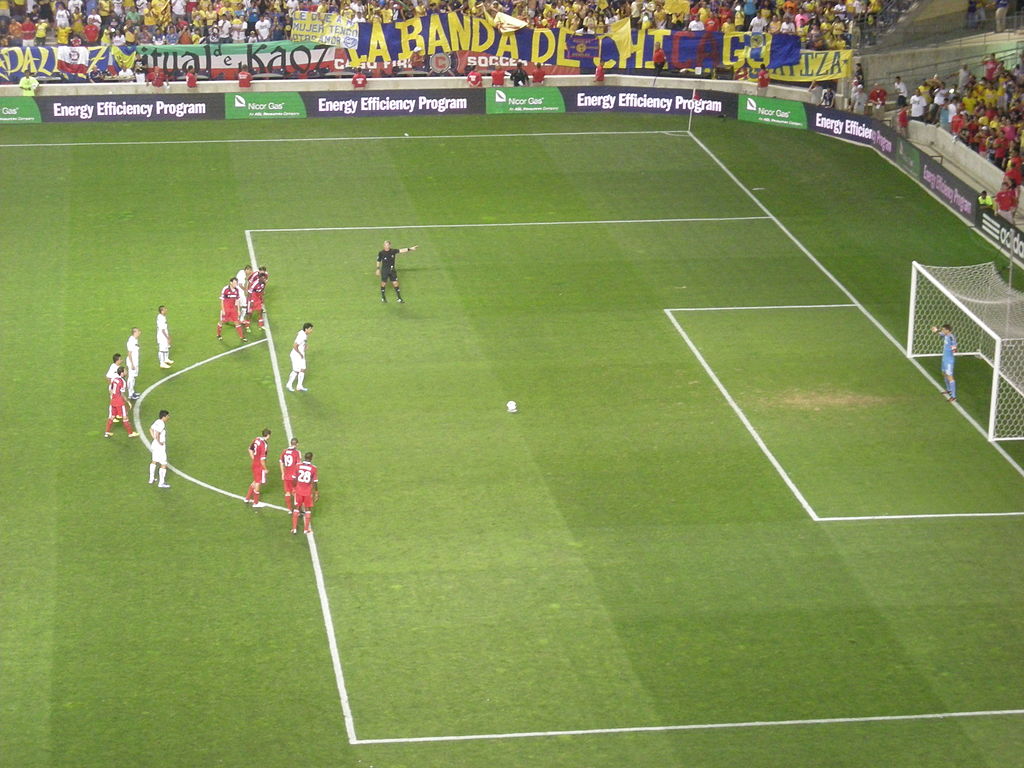 |
|---|
The characteristic distance a ball travels before air slows it down is the "Newton length". This distance can be estimated by setting the mass of the ball is equal to the mass of the air the ball passes through.
Mass of a soccer ball = M = .437 kg Ball radius = R = .110 meters Ball cross-sectional area = A = .038 meters2 Ball density = D =78.4 kg/meters3 Air density = d = 1.22 kg/meter3 (Air at sea level) Ball initial velocity = V Newton length = L Mass of air the ball passes through= m = A L d m = M L = M / (A d) = (4/3) R D / d = 9.6 metersThe depth of the penalty box is 16.45 meters (18 yards). Any shot taken outside the penalty box slows down substantially before reaching the goal.
Newton was also the first to observe the "Magnus effect", where spin causes a ball to curve.
 |
|---|
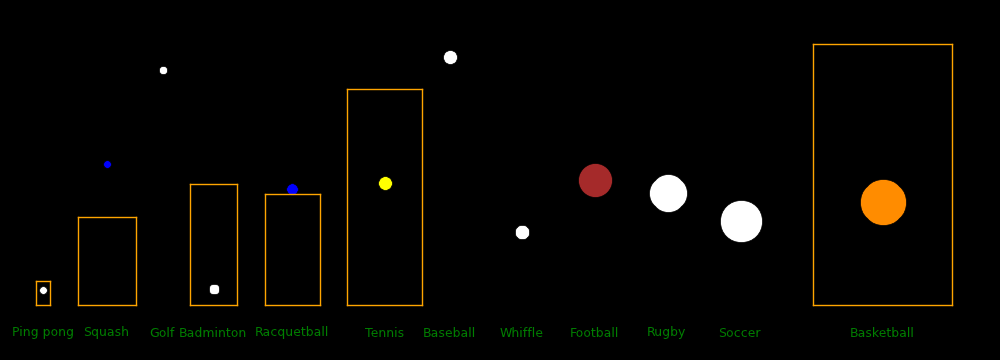 |
|---|
The orange boxes depict the size of the court and the Newton length is the distance from the bottom of the court to the ball. Ball sizes are magnified by a factor of 20 relative to the court sizes.
Diameter Mass Drag Shot Drag/ Density Ball Max Spin
(mm) (g) (m) (m) Shot (g/cm3) speed speed (1/s)
(m/s) (m/s)
Ping pong 40 2.7 1.8 2.74 .64 .081 20 31.2 80
Squash 40 24 15.6 9.75 1.60 .716
Golf 43 46 25.9 200 .13 1.10 80 94.3 296
Badminton 54 5.1 1.8 13.4 .14 .062
Racquetball 57 40 12.8 12.22 1.0 .413
Billiards 59 163 48.7 2.7 18 1.52
Tennis 67 58 13.4 23.77 .56 .368 50 73.2 119
Baseball 74.5 146 27.3 19.4 1.4 .675 40 46.9 86
Whiffle 76 45 8.1 .196
Football 178 420 13.8 20 .67 .142 20 26.8 18
Rugby 191 435 12.4 20 .62 .119
Bowling 217 7260 160 18.29 8.8 1.36
Soccer 220 432 9.3 16.5 .56 .078 40 29
Basketball 239 624 11.4 7.24 1.57 .087
Cannonball 220 14000 945 1000 .94 7.9
"Drag" is the Newton drag length and "Shot" is the typical distance of a shot, unless otherwise
specified. "Density" is the density of the ball.
For a billiard ball, rolling friction is greater than air drag.
A bowling pin is 38 cm tall, 12 cm wide, and has a mass of 1.58 kg. A bowling ball has to be sufficiently massive to have a chance of knocking over 10 pins.
Mass of 10 bowling pins / Mass of bowling ball = 2.18
To estimate the distance a bullet travels before being slowed by drag,
Air density = Dair = .012 g/cm3 Water density = Dwater = 1.0 g/cm3 Bullet density = Dbullet = 11.3 g/cm3 Bullet length = Lbullet = 2.0 cm Bullet distance in water = Lwater ≈ Lbullet Dbullet / Dwater ≈ 23 cm Bullet distance in air = Lair ≈ Lbullet Dbullet / Dair ≈ 185 meters
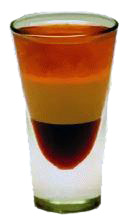 |
|---|
g/cm3 g/cm3
Air .00122 (Sea level) Silver 10.5
Wood .7 ± .5 Lead 11.3
Water 1.00 Uranium 19.1
Magnesium 1.74 Tungsten 19.2
Aluminum 2.70 Gold 19.3
Rock 2.6 ± .3 Osmium 22.6 (Densest element)
Titanium 4.51
Steel 7.9
Copper 9.0
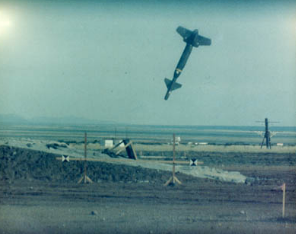 |
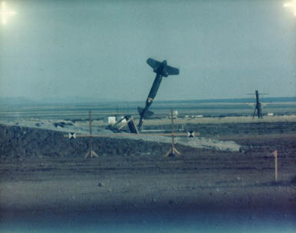 |
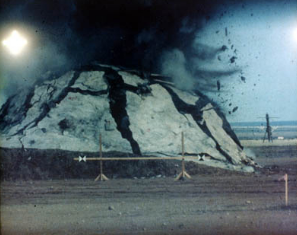 |
|
|---|---|---|---|
Cartridge Projectile Length Diameter Warhead Velocity
(kg) (kg) (m) (m) (kg) (m/s)
Massive Ordnance Penetrator - 13608 6.2 .8 2404
PGU-14, armor piercing .694 .395 .173 .030 1013
PGU-13, explosive .681 .378 .173 .030 1020
The GAU Avenger armor-piercing shell contains .30 kg of depleted uranium.
The massive ordnamce penetrator typically penetrates 61 meters of Earth.
The PGU-13 and PGU-14 are used by the A-10 Warthog cannon.
The composition of natural uranium is .72% uranium-235 and the rest is uranium-238. Depleted uranium has less than .3% of uranium-235.
 |
|
|---|---|
The drag force on an object moving through a fluid is
Velocity = V Fluid density = D = 1.22 kg/m2 (Air at sea level) Cross-sectional area = A Drag coefficient = C = 1 (typical value) Drag force = F = ½ C D A V2 Drag power = P = ½ C D A V3 = F V Terminal velocity = Vt"Terminal velocity" occurs when the drag force equals the gravitational force.
M g = ½ C D A Vt2Suppose we want to estimate the parachute size required for a soft landing. Let a "soft landing" be the speed reached if you jump from a height of 2 meters, which is Vt = 6 m/s. If a skydiver has a mass of 100 kg then the area of the parachute required for this velocity is 46 meters2, which corresponds to a parachute radius of 3.8 meters.
 |
|---|
Drag coefficient
Bicycle car .076 Velomobile
Tesla Model 3 .21 2017
Toyota Prius .24 2016
Bullet .30
Typical car .33 Cars range from 1/4 to 1/2
Sphere .47
Typical truck .6
Formula-1 car .9 The drag coeffient is high to give it downforce
Bicycle + rider 1.0
Skier 1.0
Wire 1.2
Mach
X-15 6.7 Rocket
Blackbird SR-71 3.5
X-2 Starbuster 3.2
MiG-25 Foxbat 2.83
XB-70 Valkyrie 3.0
MiG-31 Foxhound 2.83
F-15 Eagle 2.5
Aardvark F-111 2.5 Bomber
Sukhoi SU-27 2.35
F-22 Raptor 2.25 Fastest stealth aircraft
 |
|---|
Fluid density = D
Cross section = A
Drag coef = C
Drag force = F = ½ C A D V2
Drag power = P = ½ C A D V3 = K D V3 = F V
Drag parameter = K = ½ C A
Speed Density Drag force Drag power Drag
(m/s) (kg/m3) (kN) (kWatt) parameter
Bike 10 1.22 .035 .305 .50
Bike 18 1.22 .103 1.78 .50
Bike, speed record 22.9 1.22 .160 3.66 .50
Bike, streamlined 38.7 1.22 .095 3.66 .104
Porche 911 94.4 1.22 7.00 661 1.29
LaFerrari 96.9 1.22 7.31 708 1.28
Lamborghini SV 97.2 1.22 5.75 559 1.00
Skydive, min speed 40 1.22 .75 30 .77 75 kg
Skydive, max speed 124 1.22 .75 101 .087 75 kg
Airbus A380, max 320 .28 1360 435200 94.9
F-22 Raptor 740 .084 312 231000 6.8
SR-71 Blackbird 1100 .038 302 332000 6.6
Sub, human power 4.1 1000 .434 1.78 .052
Blue Whale 13.9 1000 270 3750 2.8 150 tons, 25 Watts/kg
Virginia nuclear sub 17.4 1000 1724 30000 11.4
The drag coefficient is an assumption and the area is inferred from the
drag coefficient.
For the skydiver, the minimum speed is for a maximum cross section (spread eagled) and the maximum speed is for a minimum cross section (dive).
Wiki: Energy efficiency in transportation
 |
|---|
Airplanes fly at high altitude where the air is thin.
Altitude Air density
(km) (kg/m3)
Sea level 0 1.22
Denver (1 mile) 1.6 .85
Mount Everest 9.0 .45
Airbus A380 13.1 .25 Commercial airplane cruising altitude
F-22 Raptor 19.8 .084
SR-71 Blackbird 25.9 .038
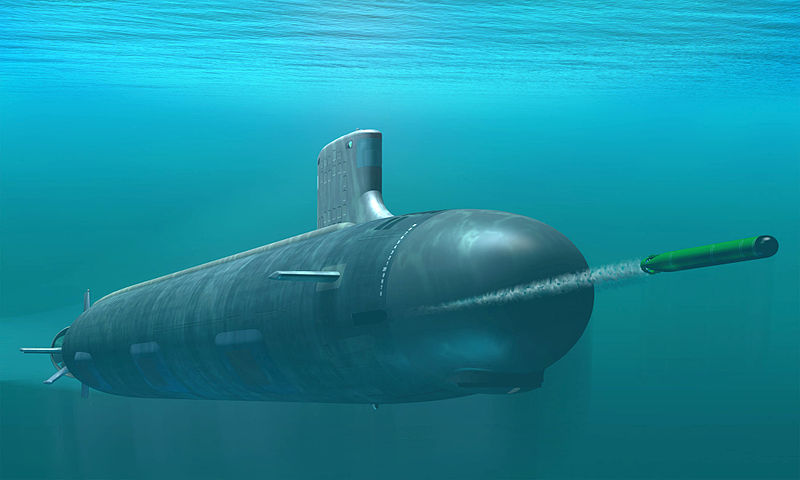 |
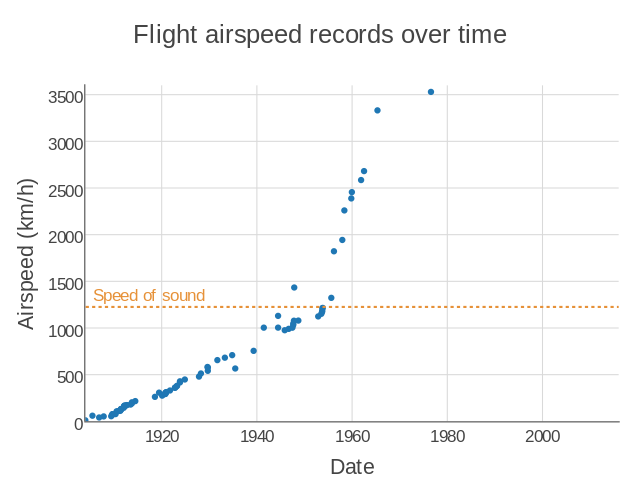 |
|
|---|---|---|
m/s Mach
Swim 2.39
Boat, human power 5.14
Aircraft, human power 12.3
Run 12.4
Boat, wind power 18.2
Bike 22.9
Car, solar power 24.7
Bike, streamlined 38.7
Land animal 33 Cheetah
Bird, level flight 45 White-throated needletail
Aircraft, electric 69
Helicopter 111 .33
Train, wheels 160 .54
Train, maglev 168 .57
Aircraft, propeller 242 .82
Rocket sled, manned 282 .96
Aircraft, manned 981 3.33
Rocket plane, manned 2016 6.83
Rocket sled 2868 9.7
Scramjet 5901 20
Mach 1 = 295 m/s at high altitude.
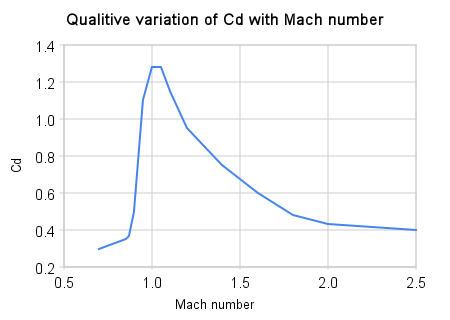 |
|---|
Commercial airplanes fly at Mach .9 because the drag coefficient increases sharply at Mach 1.
The drag coefficient depends on speed.
Object length = L
Velocity = V
Fluid viscosity = Q (Pascal seconds)
= 1.8⋅10-5 for air
= 1.0⋅10-3 for water
Reynolds number = R = V L / Q (A measure of the turbulent intensity)
The drag coefficient of a sphere as a function of Reynolds number is:
 |
|---|
Golf balls have dimples to generate turbulence in the airflow, which increases the Reynolds number and decrease the drag coefficient.
Reynolds Soccer Golf Baseball Tennis number 40000 .49 .48 .49 .6 45000 .50 .35 .50 50000 .50 .30 .50 60000 .50 .24 .50 90000 .50 .25 .50 110000 .50 .25 .32 240000 .49 .26 300000 .46 330000 .39 350000 .20 375000 .09 400000 .07 500000 .07 800000 .10 1000000 .12 .35 2000000 .15 4000000 .18 .30Data
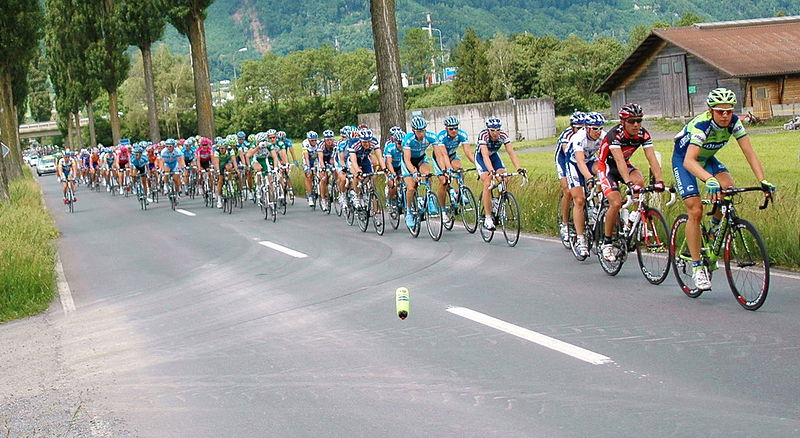 |
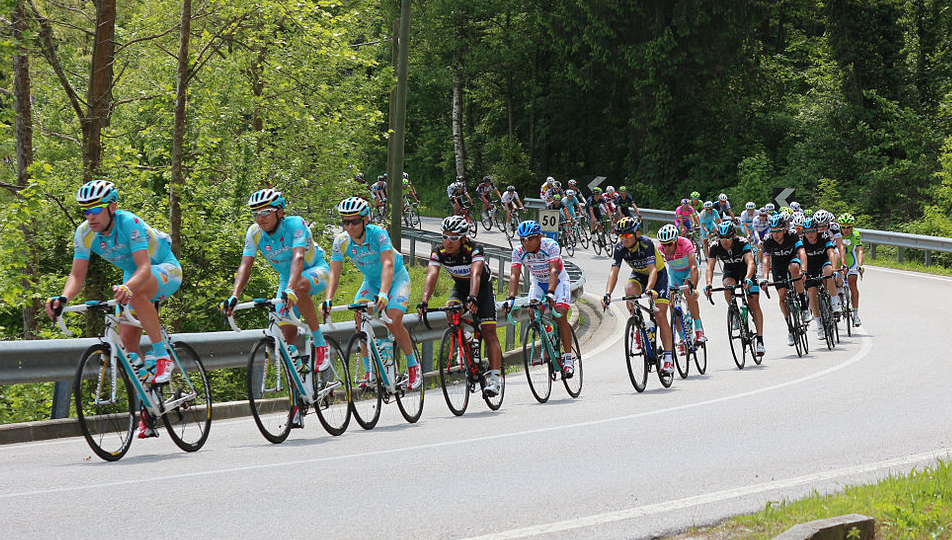 |
|---|---|
If the cyclists are in single file then the lead rider has to use more power than the following riders. Cyclists take turns occupying the lead.
A "slingshot pass" is enabled by drafting. The trailing car drops back by a few lengths and then accelerates. The fact that he is in the leading car's slipstream means he has a higher top speed. As the trailing car approaches the lead car it moves the side and passes.
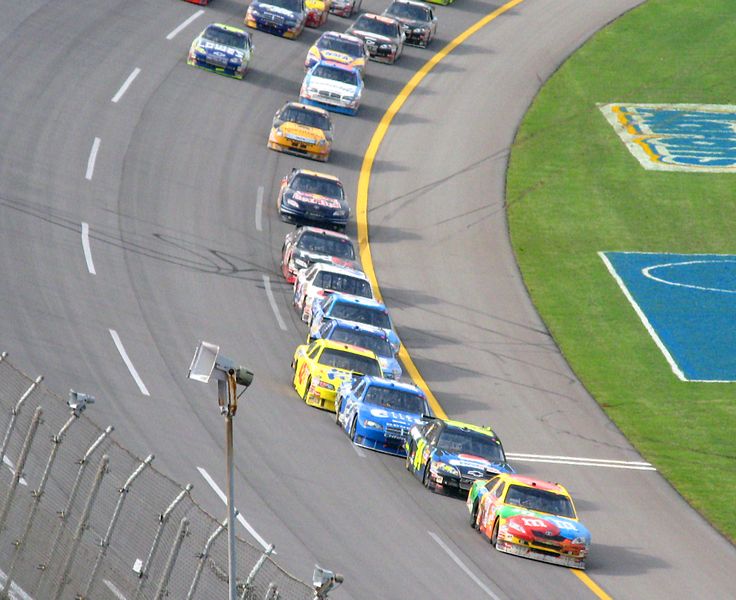 |
 |
|---|---|
For an object experiencing drag,
Drag coefficient = C Velocity = V Fluid density = D Cross section = A Mass = M Drag number = Z = ½ C D A / M Drag acceleration = A = -Z V2 Initial position = X0 = 0 Initial velocity = V0 Time = TThe drag differential equation and its solution are
A = -Z V2 V = V0 / (V0 Z T + 1) X = ln(V0 Z T + 1) / Z
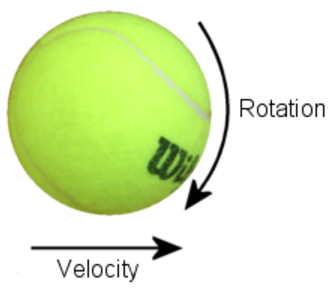 |
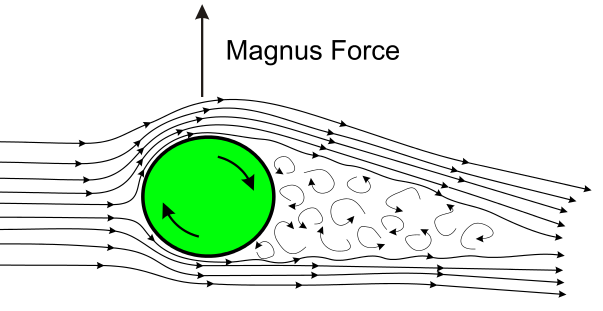 |
|---|---|
1672 Newton is the first to note the Magnus effect while observing tennis players
at Cambridge College.
1742 Robins, a British mathematician and ballistics researcher, explains deviations
in musket ball trajectories in terms of the Magnus effect.
1852 The German physicist Magnus describes the Magnus effect.
For a spinning tennis ball,
Velocity = V = 55 m/s Swift groundstroke Radius = R = .067 m Area = Area = .0141 m2 Mass = M = .058 kg Spin number = S = W R / V = .25 Heavy topspin Spin rate = W = V / R = 205 Hz Air density = Dair = 1.22 kg/m3 Ball density= Dball Drag coef = Cdrag = .5 For a sphere Spin coef = Cspin = 1 For a sphere and for S < .25 Drag force = Fdrag = ½ Cdrag Dair Area V2 = 13.0 Newtons Spin force = Fspin = ½ Cspin Dair Area V2 S = 6.5 Newtons Drag accel = Adrag = 224 m/s2 Spin accel = Aspin = 112 m/s2 Gravity = Fgrav = M gFor a rolling ball the spin number is S=1.
If the spin force equals the gravity force (Fspin = Fgrav),
The drag force on an object moving through a fluid is
V2 S C R-1 Dair/Dball = .0383

Velocity = V
Fluid density = D = 1.22 kg/m2 (Air at sea level)
Cross-sectional area = A
Drag coefficient = C
Drag force = F = ½ C A D V2
Drag power = P = ½ C A D V3 = F V
Drag parameter = K = C A
"Terminal velocity" occurs when the drag force equals the
gravitational force.
M g = ½ C D A V2
Suppose we want to estimate the parachute size required for a soft landing.
Let a "soft landing" be the speed reached if you jump from a height of 2
meters, which is Vt = 6 m/s. If a skydiver has a mass of 100 kg
then the area of the parachute required for this velocity is 46
meters2, which corresponds to a parachute radius of 3.8 meters.

Drag coefficient
Bicycle car .076 Velomobile
Tesla Model 3 .21 2017
Toyota Prius .24 2016
Bullet .30
Typical car .33 Cars range from 1/4 to 1/2
Sphere .47
Typical truck .6
Formula-1 car .9 The drag coeffient is high to give it downforce
Bicycle + rider 1.0
Skier 1.0
Wire 1.2

© Jason Maron, all rights reserved.
Data from Wikipedia unless otherwise specified.